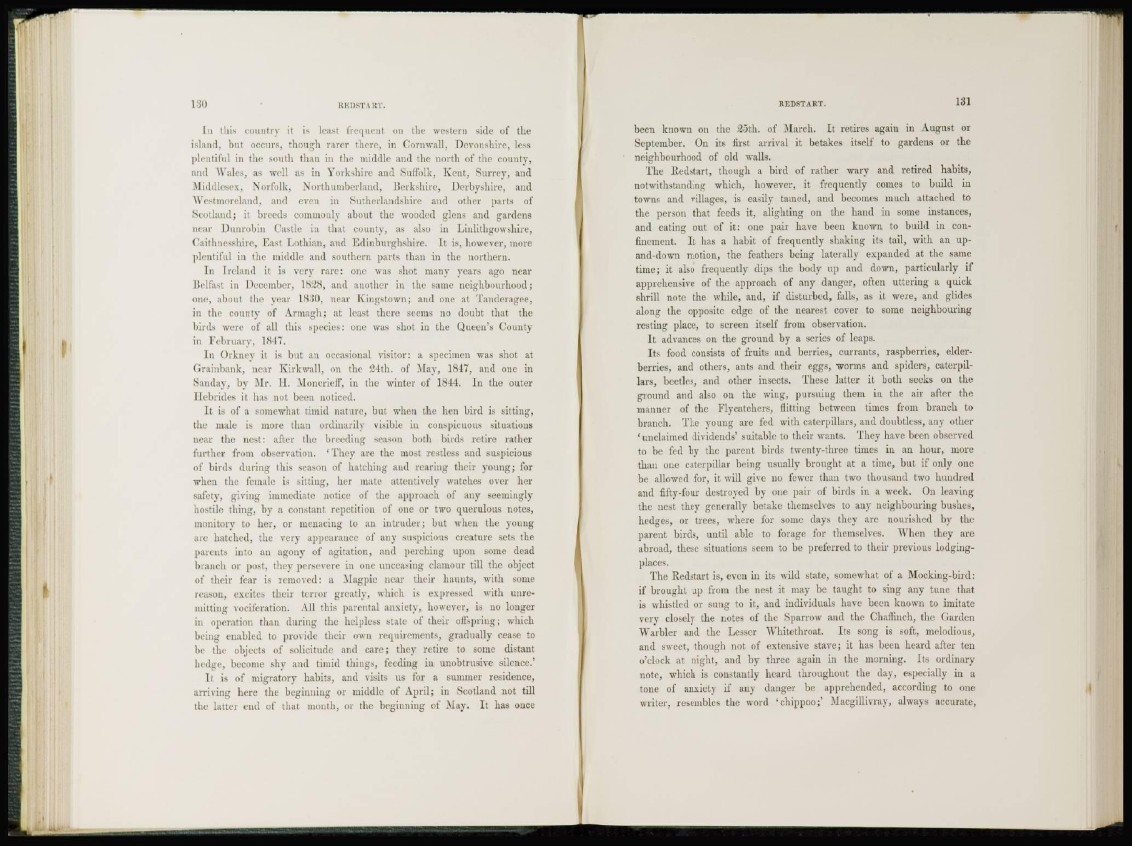
111 this country it is least frequent on the western side of the
island, but occurs, though rarer there, in Cornwall, Devonshire, less
plentiful in the south than in the middle and the north of the county,
and Wales, as well as in Yorkshire and Suffolk, Kent, Surrey, and
M iddlesex, Norfolk, Northumberland, Berkshire, Derbyshire, and
Westmoreland, and even in Sutherlandshire and other parts of
Scotland; it breeds commonly about the wooded glens and gardens
near Dunrobiu (lastle in that county, as also in Linlithgowshire,
Caithnesshire, East Lothian, and Edinburghshire. L is, however, more
plentiful in the middle and southern parts than in the northern.
In Ireland it is very rare: one was shot many years ago near
Belfast in December, 1828, and another in the same neighbourhood;
one, about the year 18.JO, near Kingstown; and one at Tauderagee,
in the county of Armagh; at least there seems no doubt that the
birds were of all this species: one was shot in the Queen's County
in February, 1847.
I n Orkney it is but an occasional visitor: a specimen was shot at
Grainbank, near Kirkwall, on the 24th. of May, 1847, and one in
Sanday, by Mr. II. Moncrieff, in the winter of 1844. In the outer
Hebrides it has not been noticed.
I t is of a somewhat timid nature, but when the hen bird is sitting,
the male is more than ordinarily visible in conspicuous situations
near the nest: after the breeding season both birds retire rather
further from observation. 'They are the most restless and suspicious
of birds during this season of hatching and rearing their young; for
when tin1 female is silting, her mate attentively watches over her
safety, giving immediate notice of the approach of any seemingly
hostile thing, by a constant repetition of one or two querulous notes,
monitory to her, or menacing to an intruder; but when the young
are hatched, the very appearance of any suspicious creature sets the
parents into an agony of agitation, and perching upon some dead
branch or post, they persevere in one unceasing clamour till the object
of their fear is removed: a Magpie near their haunts, with some
reason, excites their terror greatly, which is expressed with unremitting
vociferation. All this parental anxiety, however, is no longer
in operation than during the helpless state of their offspring; wdiich
being enabled to provide their own requirements, gradually cease to
be the objects of solicitude and care; they retire to some distant
hedge, become shy and timid things, feeding in unobtrusive silence.'
It is of migratory habits, and visits us for a summer residence,
arriving here the beginning or middle of April; in Scotland not till
the latter end of that month, or the beginning of May. It has ouce
been known on the 25th. of March. It retires again in August, or
September. On its first arrival it betakes itself to gardens or the
neighbourhood of old walls.
The Redstart, though a bird of rather wary and retired habits,
notwithstanding which, however, it frequently comes to build in
towns and villages, is easily tamed, and becomes much attached to
the person that feeds it, alighting on the hand in some instances,
and eating out of it: one pair have been known to build in confinement.
It has a habit of frequently shaking its tail, with an upand
down motion, the feathers being laterally expanded at the same
time; it also frequently dips the body up and down, particularly if
apprehensive of the approach of any danger, often uttering a quick
shrill note the while, and, if disturbed, falls, as it were, and glides
along the opposite edge of the nearest cover to some neighbouring
resting place, to screen itself from observation.
It advances on the ground by a series of leaps.
Its food consists of fruits and berries, currants, raspberries, elderberries,
and others, ants and their eggs, worms and spiders, caterpillars,
beetles, and other insects. These latter it both seeks on the
ground and also on the wing, pursuing them in the air after the
manner of the Flycatchers, Hitting between times from branch to
branch. The young are fed with caterpillars, and doubtless, any other
'unclaimed dividends' suitable to their wants. They have been observed
to be led by the parent birds twenty-three times in an hour, more
than one caterpillar being usually brought at a time, but if only one
be allowed for, it will give no fewer than two thousand two hundred
and fifty-four destroyed by one pair of birds in a week. On leaving
the nest they generally betake themselves to any neighbouring bushes,
hedges, or trees, where for some days they are nourished by the
parent birds, until able to forage for themselves. When they are
abroad, these situations seem to be preferred to their previous lodgingplaces.
The Redstart is, even iu its wild state, somewhat of a Mocking-bird:
if brought up from the nest it may be taught to sing any tunc that
is whistled or sung to it, and individuals have been known to imitate
very closely the notes of the Sparrow and the Chaffinch, the Garden
Warbler and the Lesser YVhitethroat. Its song is soft, melodious,
and sweet, though not of extensive stave; it has been heard after ten
o'clock at night, and by three again in the morning. Its ordinary
note, which is constantly heard throughout the day, especially in a
tone of anxiety if any danger be apprehended, according to one
writer, resembles the word 'chippoo;' Macgillivray, always accurate,